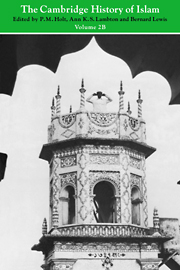Book contents
- Frontmatter
- Introduction
- PART VIII ISLAMIC SOCIETY AND CIVILIZATION
- 1 THE GEOGRAPHICAL SETTING
- 2 THE SOURCES OF ISLAMIC CIVILIZATION
- 3 ECONOMY, SOCIETY, INSTITUTIONS
- 4 LAW AND JUSTICE
- 5 RELIGION AND CULTURE
- 6 MYSTICISM
- 7 REVIVAL AND REFORM IN ISLAM
- 8 LITERATURE
- 9 ART AND ARCHITECTURE
- 10 SCIENCE
- 11 PHILOSOPHY
- 12 WARFARE
- 13 THE TRANSMISSION OF LEARNING AND LITERARY INFLUENCES TO WESTERN EUROPEo
- Dynastic List
- Bibliography
- Glossary
- Index
- References
9 - ART AND ARCHITECTURE
from PART VIII - ISLAMIC SOCIETY AND CIVILIZATION
Published online by Cambridge University Press: 28 March 2008
- Frontmatter
- Introduction
- PART VIII ISLAMIC SOCIETY AND CIVILIZATION
- 1 THE GEOGRAPHICAL SETTING
- 2 THE SOURCES OF ISLAMIC CIVILIZATION
- 3 ECONOMY, SOCIETY, INSTITUTIONS
- 4 LAW AND JUSTICE
- 5 RELIGION AND CULTURE
- 6 MYSTICISM
- 7 REVIVAL AND REFORM IN ISLAM
- 8 LITERATURE
- 9 ART AND ARCHITECTURE
- 10 SCIENCE
- 11 PHILOSOPHY
- 12 WARFARE
- 13 THE TRANSMISSION OF LEARNING AND LITERARY INFLUENCES TO WESTERN EUROPEo
- Dynastic List
- Bibliography
- Glossary
- Index
- References
Summary
PRIMITIVE ISLAM
The proper usage of the collective name ‘Islamic art’ has been seriously questioned by a number of scholars during the past two or three decades. As alternatives ‘Arab art’, ‘Persian art’, ‘Turkish art’ have been suggested. Others have even gone as far as denying any common ground or characteristics in this art, and claimed that it should be simply named after the respective country where the monuments stand or where particular art objects were produced. It seems desirable, therefore, before describing the achievements of Islamic art, to answer these critics; to define, as far as is possible, the common characteristics of Islamic art, to reveal its sources and to throw some light upon the foreign influences which contributed to its evolution.
It is a well-known and accepted fact that the Arabs had hardly anything which could be called art when they set out to invade the territories in the north. There was a highly developed architecture in southern Arabia well before the advent of Islam, but that had hardly anything to do with those primitive tribesmen who were united under Islam, and who constituted the backbone of its victorious army. Neither had the Prophet any intention of giving an impetus to a religious art. Indeed, we cannot talk about Islamic art in a religious sense, as we can talk about Christian or Buddhist art.
It was the helping hand of highly skilled craftsmen and artists of the conquered territories which provided the resources needed to erect and adorn the earliest religious and secular buildings of Islam. The effect of these cultures—Byzantine, Coptic, Sasanian and later on Central Asian—can be clearly recognized and distinguished in the early period.
- Type
- Chapter
- Information
- The Cambridge History of Islam , pp. 702 - 740Publisher: Cambridge University PressPrint publication year: 1977



